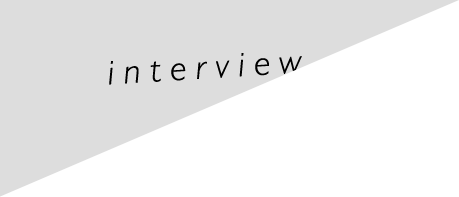
2014年の『花椿』の表紙、そして、2015年はビューティー企画を連載中の写真家のイナ・ジャンさん。韓国で生まれ、日本にも在住経験があり、現在はNYを拠点に活躍する、韓国語、日本語、英語を操る女性です。ピンクや水色などのパステルカラー、ユーモア溢れるポージングと小道具の使い方が特長の彼女の作品は、可愛くて、なんだか不思議な雰囲気です。いつも楽しく、そして新しいアイデアをみせてくれる彼女の創作のインスピレーション源についてお話を聞きました。
Photographer Ina Jang’s work was featured on the cover of Hanatsubaki magazine in 2014 and is being serially published in the Beauty column throughout 2015. Born in Korea, a former resident of Japan, and currently living in New York, She is a woman with the skills to express herself in Korean, Japanese and English. Her photographs characterized by pastel colors such as pink and sky blue, humorous poses and fascinating use of objects, is cute and full of wonder. We speak to Jang to find out where she gets her inspiration for her constant flow of fun and new ideas.
小さな頃から、テレビやビジュアル的なものはすごく好きで何かを表現したいと思っていましたが、何をやったらいいのかわからずにいて、韓国の大学で日本語を勉強していました。今はもう日本語がだいぶ下手になってしまいましたけど(笑)。その頃は、マンガの『ベルサイユのばら』も読めてました!大学での日本語の勉強に物足りなさを感じ、大学を休んで日本に住んでいた20歳の誕生日に、母親からインスタントカメラの「ロモ」をプレゼントしてもらいました。その時は妹と一緒に住んでいましたが、日本で友達がいなくて退屈だったし、ロモで撮影すると色が面白く出るので、毎日毎日何でもたくさん撮っていました。それから妹の日常を撮影するようになりましたが、次第に妹を撮っていることにも飽きてきて、その頃から空想したビジュアル・イメージをスケッチにして、妹というモデルを使って写真で具現化するようになりました。そのスタイルは、私の創作のベースとなっていると思います。
例えば、“東京タワーとピンクのマフラーをつけた妹”のスケッチを描いて、それを再現したり、“代々木公園では青いリボンがないとだめ”とか、そんな撮影を続けているうちに、ちゃんと写真の勉強がしたいと思い、ニューヨーク・スクール・オブ・ビジュアルアーツに入学しました。なので、写真との出会いは、母がくれたロモと日本に暮らしていて時間があったこと(笑)だと思います。時間があったからこそ、空想したり、夢見たり、何よりたくさんシャッターをきることができました。
When I was still a child, I was really into watching TV and other visual media. I wanted a medium to express myself, but I had no idea what I wanted to do, so I decided to study Japanese at a Korean university. At that time, I was even able to read the Japanese comic, The Rose of Versailles! Now my Japanese has become quite rusty (laughs). I didn’t feel that my Japanese was improving at university so I took a break from my studies and moved to Japan. On my 20th birthday, my mother sent me a Lomo instant camera as a birthday present. I was living with my younger sister at that time and since I had no friends in Japan and I was bored, I walked around every day taking tons of pictures with my Lomo which created images with unusual color. I started taking shots of my sister as she went about her day, but when I got bored of doing that, I started sketching imaginary visual images. Using my sister as a model, I recreated these images using photography. That style has become the base of my creations.
For instance, I would sketch Tokyo Tower and my sister wearing a pink scarf and recreate this image on camera, or become adamant about the need for a blue ribbon at Yoyogi Park. As I photographed these images, I developed a desire to study photography, so I enrolled at the School of Visual Arts in New York. So, I guess the Lomo camera from my mother and the time I spent living in Japan (laughs) are what got me into photography. I had a lot of time on my hands which gave me the freedom to use my imagination, to dream, and to take as many pictures as I wanted.
私の創作にとってスケッチは欠かせないものですね。アイデアを考えるときはいつもスケッチから始まるので、それをそのままグラフィックに表現できないと、気持ちが悪いんです。
それと、“色と光”ですね。東京にいるときは照明の使い方もわからなかったので、スケッチで描いた世界を外で再現し、それを自然光で撮っていましたが、NYに移っても、大学3年生になるまでモデルを使い、スケッチに合うロケーションを探して撮影ばかりしていたのでモノを撮ったことはありませんでした。でもNYでロケーションを探すのに毎度苦労していたので、あるときたまたま教室で撮影をしてみたんです。糸が垂れている黒板の前に立った男子の作品です。それを見た先生に、「モノだけ撮ってみたら?」と言われ、室内でモノの撮影にトライしてみると、室内の白い壁が真っ白な無地のノートのような気がして、スケッチの世界を演出するのにとても都合がいいことに気がつきました。けれど室内での撮影を始めてからもまだ照明は使わず、自然光でした。照明については最近は少しわかってきましたが(笑)、学生時代からの仲間のジェイやマイクが私の理想とする色を作り出してくれています。
My sketches are a very important part of my work. My ideas always start from a sketch, and it feels weird to me when I can’t express these ideas in graphics.
Color and light are also important elements in my work. When I lived in Tokyo, I had no idea how to manipulate lighting, so I recreated the world in my drawings outside and photographed these images using natural light. Even after moving to New York, until I was in my third year, I always shot models at locations that matched my drawings and I never photographed things or objects. In New York, however, I struggled to find locations for my shoots, and one day I just tried shooting inside the classroom. It was a photograph of a boy standing in front of a blackboard with a dangling thread. That’s when my instructor suggested that I try taking photographs of only objects. When I gave it a try, the white walls began to feel like empty pages in a notebook to me and that’s when I realized that these walls could be used to recreate the world inside my sketches. Even after I started shooting indoors, I continued to use natural light rather than artificial light. It’s only recently that I’ve started to get the grasp of using artificial lighting (laughs), and Jay and Mike, friends of mine since my university days, help me to create the colors that I’m after.
そうですね、たくさんありますね。
本を読んでいて、英語の本で意味がわからないけど、響きのよい単語に出会って、それについていろいろ思いをめぐらしたりすることからアイデアが生まれることがよくあります。小説とか雑誌とか何でもいいんです。私はもともと言語が好きで、日本語でも韓国語でも英語でもそうですが、単語の響きが気になると、のめりこんで、意味や成り立ちを調べたりしますね。その言語のイメージをビジュアル化する感じです。あとは色自体だったり、岩や鳥など、日常生活で目に留まったもの。それらを愛用のモレスキンのノートに書き留めています。そのアイデアストックからイメージが浮かびあがり、スケッチとなり、そして作品になっていく感じです。昔は夢でみたものをスケッチに使っていたりもしましたが、最近は深く眠っていて夢を見ないようなので、あんまり使えないですね(笑)。
My inspiration comes from many sources.
I get my ideas from reading books and even though it’s in English and I don’t fully understand what I’m reading, I encounter words that are like music to my ears and as I turn these words over in my head they often spur ideas. It could be anything like a novel or magazine. I’ve always had a thing for languages, and whether a word is Japanese, Korean or English, if I like how it sounds, I get engrossed in finding out what it means or the etymology behind the word. It’s like visualizing the image of the words in my head. Other things that inspire me are colors, rocks, birds and anything that catches my eye as I go about my day. I write all these down in my beloved Moleskine notebook. The images in my head are derived from the stock of ideas in my notebook which are converted into sketches and transformed into one of my creations. In the past, I also sketched images that appeared in my dreams, but recently, I can’t seem to get into a deep enough sleep to dream, so my dreams are no longer of much help to me (laughs).
写真作品はあまり見ないですが、自分の学校の写真学科の学科長の写真はとても好きでした。友人が、たまたま彼の昔の希少な写真集をみつけて見せてくれてくれたんです。その写真集は、写真のグロッサリー(*書籍の巻末にある用語解説。また、特定の分野・作家の術語や語彙などを解説した小辞典。用語解)のような気がしました。写真のA、写真のB、AとBをあわせてCになるということを説明しているような……ものだったのですが、なんだか彼の感性と自分の感性に親和性を感じました。それに彼は作品をほとんど外に発表していなくて、自分が撮りたいもの、幸せになる作品をつくり続けるスタイル。私もそういう、自分が幸せになる写真が撮りたい。まだ若いから、コマーシャルもやらなきゃいけないですけど(笑)。
人を撮影する機会も多いので、人間は好きだけど、本当は引きこもりで、家で一人でいる時間が大好き。家の中で空想したり、いろいろ考えたり、撮影したりしていることが多かったのですが、最近はもっと外にでて、もっと人に会って、新しい人やモノを撮ることも自分の役に立つんじゃないかと思っています。この歳で自分のスタイルが固まりすぎてしまっては、ポシビリティを下げてしまうのではないかと思ったりしているので、挑戦ですね。
I don’t really look at photographic work, but I’m really fond of the photographs taken by the dean of the Department of Photography I was enrolled at. A friend of mine happened to find a rare collection of the photographs that the dean had published in the past and showed it to me. It was almost like a glossary of photographs. It was like an explanation of how he took Photograph A and Photograph B and combined them to create Photograph C, and I somehow felt an affinity of sensibilities with him. He has rarely made his work public, and his style continues to revolve around taking what he wants and creating images that make him happy. I also want to take photographs that make me happy. But I’m still young, so I also need to make commercials (laughs).
I take a lot of photographs of people so I love being around people, but I’m actually a recluse and love to spend time at home alone. I used to spend a lot of time at home lost in imagination, thinking about things, and taking pictures, but I’ve discovered recently that going out to meet people and taking photographs of new people or objects is also valuable. If I solidify my style too much at this age, I’m afraid that I may miss out on possibilities so I’ll keep taking on challenges.
なんて難しい質問!美とは、最も複雑な概念の一つではないでしょうか。数年前の私だったら、この問いに対し、自分にとっての美とは「エレガントで、ミニマルで、胸を打たれるもの」だと答えていたかもしれません。今でもそうした要素は重要に思いますが、それは表面的な部分です。むしろ、時間をかけて考えれば考える程、美とは「人生に対する姿勢」なのだという思いが止まりません。他人との付き合い方、毎日をどうやって生きるか、自分の考えをどれほど深く掘り下げられるか…。こういうこと全てが、美の概念を決めるのに重要なのだと思います。
It's such a difficult question! Beauty is possibly one of the most complex concepts. If I was asked this question a few years ago, I might have answered that something elegant, minimal and poignant is 'beautiful' to me. Still, those values are appealing to me on the superficial level. However, the more I spend time with the idea, I cannot stop thinking that 'Beauty' is very much about attitude towards life. How we treat others, how we live everyday and how deep we look into our own thoughts...all matters to define the concept of 'Beauty'.
1982年韓国生まれ。現在は、ニューヨークを拠点に活動。2010年、ニューヨーク・スクール・オブ・ビジュアルアーツを卒業後、2012年に同校MPSファッション・フォトグラフィーで学ぶ。2011年には、イエール国際モード&写真フェスティバルのファイナリストにノミネートされ、若手作家の登竜門「FOAM Talent」にも選出された。2015年2月にはニューヨークのFoley Galleryにて個展「all rose are red, all birds are blue」が開催された。
Born in Korea in 1982 and currently resides in New York. After graduating from the School of Visual Arts in New York in 2010, she studied MPS Fashion Photography at the same institution in 2012. In 2011, she was nominated as the finalist for the International Fashion and Photography festival of Hyeres and was also selected as FOAM Talent, a gateway for young artists. In February 2015, she held a personal exhibition entitled “all roses are red, all birds are blue” at the Foley Gallery in New York.

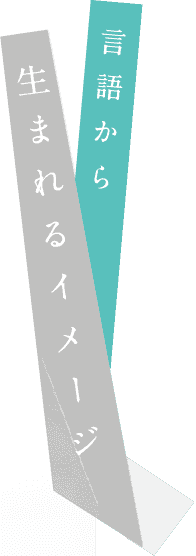

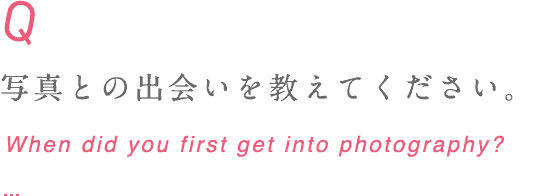
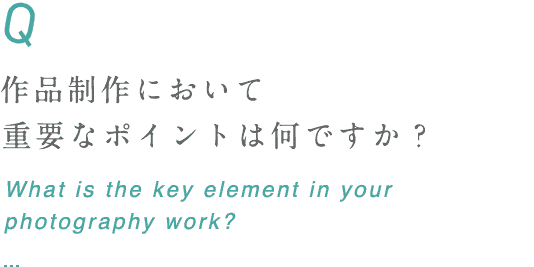
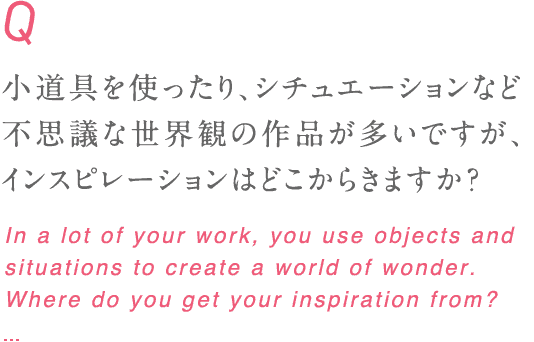
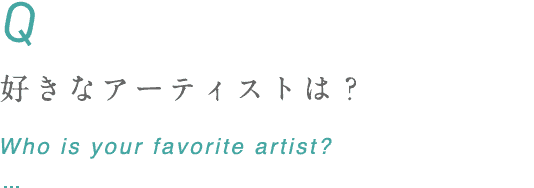
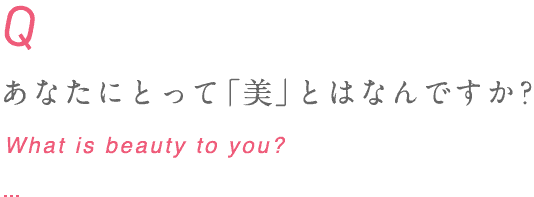
![Photographer イナ・ジャン [Ina Jang]](/sp/hanatsubaki/2015elegance/img/interview/profile_name.png)